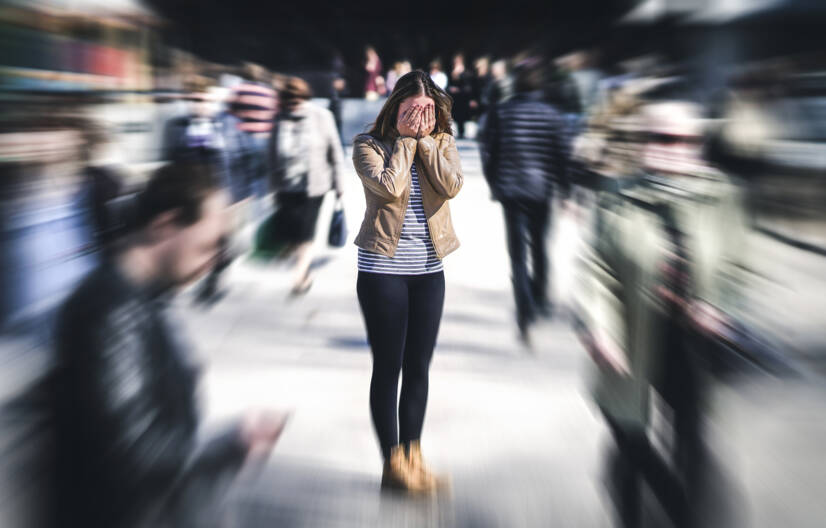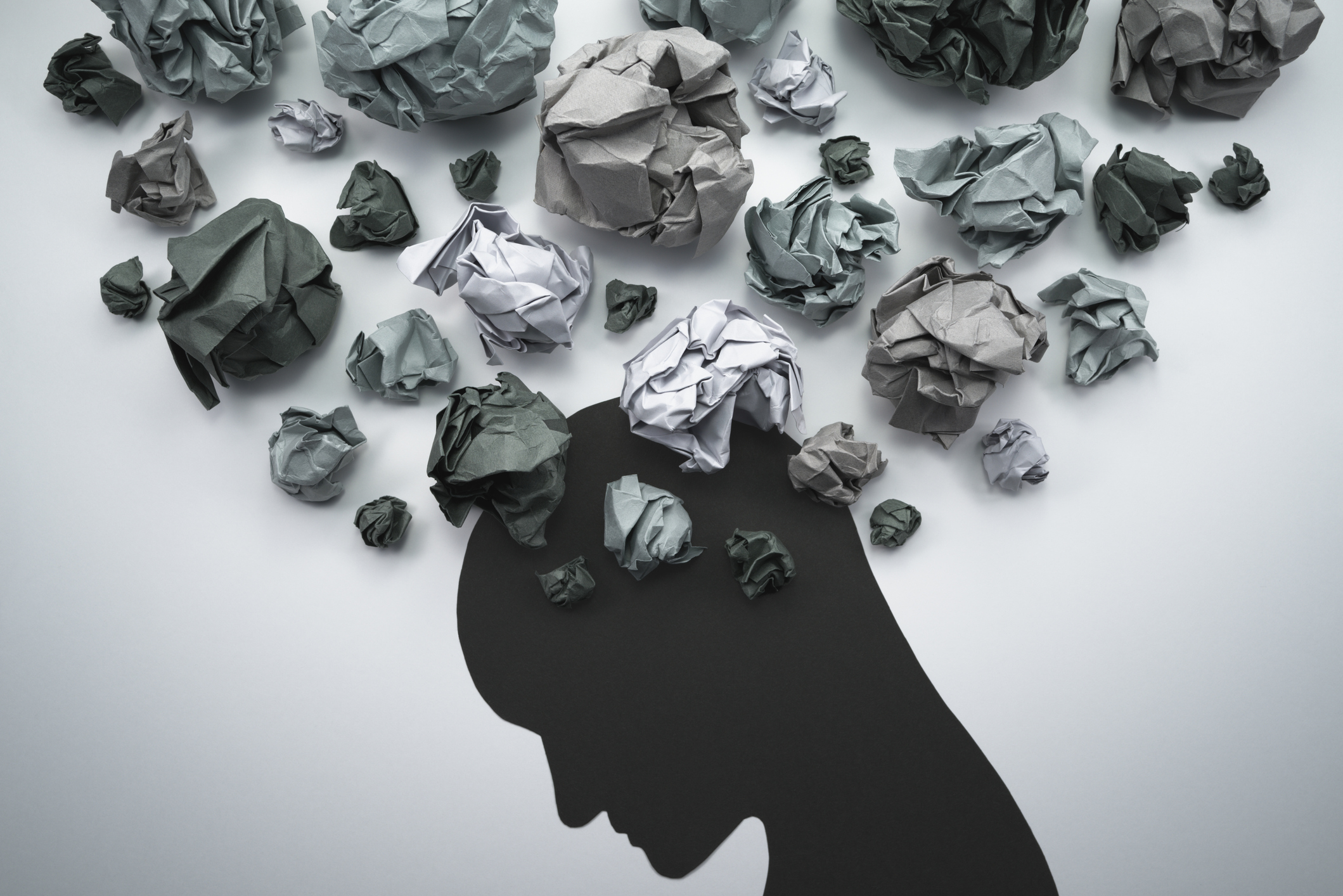- psychiatry.org - What Are Anxiety Disorders?, Philip R. Muskin, M.D., M.A.
- nimh.nih.gov - Anxiety Disorders
- ncbi.nlm.nih.gov - Dietary and botanical anxiolytics, Elham Alramadhan, Mirna S. Hanna, Mena S. Hanna, Todd A. Goldstein, Samantha M. Avila, Benjamin S. Weeks
- adaa.org - Understanding Anxiety, Facts & Statistics
- ncbi.nlm.nih.gov - Emerging Drugs for the Treatment of Anxiety, James W. Murrough, M.D., Sahab Yaqubi, M.D., Sehrish Sayed, M.P.H., Dennis S. Charney, M.D.
- solen.sk - Hypnotics and anxiolytics, Branislav Mot'ovsky, M.D.
- solen.sk - Diagnosis and treatment of anxiety disorders, Branislav Mot'ovsky, M.D.
Anxiolytics or what treatment for anxiety do we know?

Photo source: Getty images
Do you experience situations where you feel fear, worry or anxiety in everyday activities? Is anxiety a natural part of our lives or can it be considered a problem?
Article content
- Anxiety disorders - what do we know about them?
- What can be the causes of these disorders?
- What types of anxiety disorders are we familiar with?
- How do these disorders manifest themselves?
- Complications of anxiety disorders and their prevention
- What does the diagnosis and treatment of anxiety disorders involve?
- Anxiolytics of herbal origin or as dietary supplements
A difficult exam at school, an important job interview or a recital in front of a crowd. Can you remember any of these situations in your life? And do you remember how you felt at that moment?
Heart pounding, hands shaking and sweat all over your body. You probably found yourself in the grip of anxiety.
Anxiety is a condition characterized by an inner feeling of unease, nervousness or even fear. It is associated with outward physical manifestations. It is usually a temporary reaction of the body to an ongoing stressful situation.
And it is a natural reaction.
In some cases, it's even useful. It helps us to increase our attention, to focus or to recognise impending danger.
When the stressful situation subsides, the anxiety naturally subsides.
But what to do when anxiety gets out of control?
We speak of anxiety as a pathological condition when it significantly interferes with our daily life and activities.
That is, if it is intense, excessive, occurs frequently and in situations that we do not normally consider stressful, or if anxiety recurs regularly.
Chronic and irrational anxiety in response to ordinary life events is considered an anxiety disorder.
Anxiety disorders - what do we know about them?
Anxiety disorders are a group of psychiatric illnesses. They are one of the most common forms of emotional disorders.
We speak of a type of anxiety disorder when:
- Anxiety or fear significantly interferes with and reduces your ability to function in everyday life.
- You often react inappropriately emotionally.
- You do not have enough control over your reactions.
The negative side of these disorders is that they are highly restrictive and debilitating. Their development can lead to avoidance of activities or places that trigger negative emotions and symptoms.
Anxiety disorders affect all ages, but are much more common in women.
What is behind the development of anxiety disorders, or what is physiologically wrong in the body?
Anxiety disorders are the result of one of two non-physiological processes taking place in the body.
The first is an imbalance in the levels of neurotransmitters in the part of the brain that is responsible for perceiving and evaluating threats. Specifically, we are talking about an imbalance in the levels of serotonin, dopamine and gamma-aminobutyric acid (GABA).
Neurotransmitters are low molecular weight chemicals responsible for the transmission of nerve signals in the nervous system.

The second process is the disruption of the hypothalamus-pituitary-adrenal axis, i.e., impaired secretion of cortisol, adrenaline and noradrenaline.
The hypothalamus-pituitary-adrenal axis is the primary pathway by which the body responds to stress. The hypothalamus, through stimulation of the pituitary gland, causes the release of cortisol, adrenaline and noradrenaline from the adrenal glands.
Cortisol is a stress hormone that - simply put - gives us energy to cope with stressful situations. Adrenaline and noradrenaline are hormones that increase heart rate and make breathing faster.
Now that we know the course of anxiety disorders, let's look at the causes of anxiety disorders themselves.
What can be the causes of these disorders?
Anxiety disorders can arise from a variety of causes. However, the exact cause of their onset is not yet fully understood.
It is believed that a combination of factors are involved in the onset of anxiety disorders.
Table of factors that increase the likelihood of anxiety disorders
1. Imbalance of chemicals in the body
|
2. Environmental factors
|
3. Hereditary factors
|
Anxiety is a very common symptom of other psychiatric illnesses, especially depression. In the case of depression, the relationship works both ways. Anxiety can lead to depression and in turn depression can lead to anxiety.
Feelings of anxiety are also very common in patients with other (not only psychiatric) illnesses, for example, chronic fatigue, diabetes, thyroid disorders, heart or lung disease, chronic pain or withdrawal symptoms (alcohol, drugs, medication).
In addition, chronic anxiety is associated with a risk of increased morbidity and mortality.
What types of anxiety disorders are we familiar with?
There are several basic types of anxiety disorders - generalised anxiety disorder, panic disorder, obsessive-compulsive disorder, phobias, post-traumatic stress disorder, agoraphobia and others.
Several anxiety disorders can occur simultaneously in one patient.
All arise from an imbalance of neurotransmitters in the central nervous system and/or a disturbance of the hypothalamic-pituitary-adrenal axis.
Generalised anxiety disorder
Characterised by persistent and excessive worry. The problem or threat is non-existent or negligible.
People with this disorder are constantly frightened and unable to relax, which interferes with their daily activities. They are unable to concentrate sufficiently and have difficulty sleeping.
In mild forms of generalised anxiety disorder, patients are able to work and lead a more or less normal social life. Severe forms of anxiety disorder are usually associated with loss of employment and avoidance of social contact.
Panic disorder
This is a sudden attack of fear or despair. It arises in response to a feared situation/object or occurs unexpectedly, i.e. without cause. It is unpredictable and lasts for approximately 10 minutes.
The attack is characterised by an increased heart rate, sweating and dizziness, possibly shortness of breath, nausea and chest pain. People with a panic attack often confuse these symptoms with a heart attack.
Patients with panic disorder avoid places where they have had a panic attack in the past or places that remind them of this situation.
Obsessive-compulsive disorder
Characterised by persistent and recurrent thoughts (obsessions). These thoughts lead to anxiety, which then leads to repeated performance of certain compulsive activities (compulsions) in an attempt to relieve the anxiety.
An example is thinking about the presence of bacteria in the environment around us (obsession), followed by frequent hand washing (compulsion), then repeatedly checking things (locked doors, switched off appliances in the house), doing tasks in a certain order, etc.
Read more in the article:
What is Obsessive Compulsive Disorder + Symptoms and Treatment
Phobias and Social Phobias
This is an unreasonable and excessive fear of certain objects, situations or activities that are generally not dangerous. The patient is aware that his fear is excessive but cannot control or overcome it.
Examples are fear of flying, spiders, heights, etc.
Social phobia is a fear of everyday social situations and interactions with people. It is a fear of embarrassment, humiliation, rejection or being ignored by society that leads to avoidance of these situations.
Post-traumatic stress disorder
This disorder arises as a result of a traumatic or violent event that happened in the patient's past (accident, violent crime, natural disaster). The situation comes back to him in the form of a nightmare or vivid memories.
Agoraphobia
Agoraphobia occurs in people in situations where they feel that they cannot escape or that they will not get help if they need it.
It includes, for example, a fear of enclosed spaces, of public places, of crowds, of leaving home, of travelling on public transport, of standing in queues, of lonely places, etc.

How do these disorders manifest themselves?
The symptoms of anxiety disorders depend on the type of disorder and also on the individual patient.
In these disorders, psychological symptoms are very often combined with physical symptoms. Sometimes there are also changes in the person's behaviour.
A tabular overview of the most common symptoms of anxiety disorders
| Psychological symptoms | Physical symptoms | Behavioural changes |
|
|
|
Complications of anxiety disorders and their prevention
One of the most common complications of anxiety disorders, especially if not controlled and treated, is the development or worsening of other mental and physical disorders.
For example, we are talking about the development of depression, substance dependence, chronic digestive problems, chronic pain, or the development of social isolation, problems functioning at school or work, reduced quality of life and suicidal thoughts.
Because the exact cause of anxiety is unknown, prevention of anxiety disorders involves efforts to reduce the negative impact of symptoms on the individual.
Patients with a pre-existing anxiety disorder should remain active and engage in activities that they enjoy and feel good about. They should avoid alcohol, drugs or excessive caffeine, which exacerbate anxiety.
Reducing stress, eating healthily, getting enough sleep or stopping smoking can also help to improve symptoms.
Certain medications can also make anxiety symptoms worse. Check with your doctor or pharmacist to see if this is also the case with the medications you are currently taking.
Last but not least, knowing your disorder and seeing a doctor is an essential step.
In what situations do I need to see a doctor?
- If you experience excessive worry that negatively affects your functioning at work, interpersonal relationships, or any other area of your life.
- If you do not control your fear and anxiety sufficiently.
- If you suffer from another mental illness.
- If you experience anxiety in conjunction with depressive feelings, alcohol or drug use.
- If you suspect that your anxiety may be related to a physical illness.
- If you are experiencing suicidal thoughts or behaviour.
What does the diagnosis and treatment of anxiety disorders involve?
The first step in diagnosing anxiety disorders is to rule out a physical illness that could be the primary cause.
The diagnosis of anxiety is usually subjective and is based largely on observation. It consists of a mental health assessment, a psychological questionnaire and sometimes clinical tests to rule out other illnesses with similar or the same symptoms.
Currently, screening tests are available to determine the cause and even the severity of anxiety.
Treatment of anxiety disorders consists of several steps that always work as an integrated set of measures.
Each anxiety disorder has a unique profile. Most disorders respond to a set of regimen measures or pharmacological treatment.
Regimen measures include, for example, lifestyle modification, diet, relaxation and meditation therapy, psychotherapy, behavioural therapy or cognitive behavioural therapy.
Pharmacological treatment means treatment with medication.
These two treatments work alone or in combination.
Behavioral therapy teaches the patient to change habitual behaviors that may be contributing to feelings of anxiety.
The goal of cognitive-behavioural therapy is to help the patient change his or her habitual ways of thinking and reacting in addition to the behaviour itself, so that feelings of anxiety are reduced.
In some cases, exposure therapy is also used. This involves exposing the patient to situations or objects that trigger fear and anxiety, with the aim of gradually removing them.

Several groups of drugs are used in the pharmacological treatment of anxiety disorders. We are talking about drugs with anxiolytic effect. These drugs do not primarily treat anxiety disorders, but they bring relief from their negative symptoms.
The aim of treating anxiety with medication is not only to suppress its psychological symptoms, but also to alleviate the physical ones.
A tabular overview of the groups and individual examples of drugs used in the treatment of anxiety disorders
| Medication group | Examples of medications |
| Benzodiazepines | alprazolam, clonazepam, diazepam, lorazepam, midazolam |
| Antidepressants | Selective serotonin reuptake inhibitors - fluvoxamine, fluoxetine, citalopram, escitalopram, sertraline |
| Monoamine oxidase inhibitors - tranylcypromine, phenelzine, moclobemide | |
| Tricyclic antidepressants - amitriptyline, imipramine, clomipramine, dosulepin | |
| Anxiolytics (older names for tranquillisers) | buspirone |
| Antihistamines | hydroxyzine |
| Beta-blockers | propranolol, metoprolol, pindolol, mettipranol |
How do these drugs work?
Although all of the above drugs produce an effect in the form of relieving anxiety symptoms, each group of drugs has a slightly different mechanism of action.
Benzodiazepines work by prolonging the action of gamma-aminobutyric acid. This acid is an inhibitory neurotransmitter that acts in the brain. It reduces the activity of nerve cells. It ensures that the nerve signals produced are balanced and not exaggerated.
By this mechanism, benzodiazepines provide rapid relief from symptoms of anxiety. In addition to their anxiolytic effect, they are sedative, hypnotic, skeletal muscle relaxant and anticonvulsant.
Dependence and tolerance to benzodiazepines can develop with their use. In high doses, they depress respiration and cardiac activity.
Antidepressants are potent anxiolytics that are used particularly when anxiety occurs in association with depression. They act by modifying disturbances in neurotransmitter systems, i.e. serotonin, dopamine or noradrenaline levels.
- Selective serotonin reuptake inhibitors increase serotonin levels.
- Monoamine oxidase inhibitors decrease the breakdown of serotonin, noradrenaline and dopamine, thereby increasing their levels.
- Tricyclic antidepressants block the reuptake of serotonin and noradrenaline, thereby increasing their levels.
The anxiolytic buspirone is a serotonin receptor agonist. It produces similar effects in the body to serotonin.
It has comparable effects to benzodiazepines but causes minimal sedation and does not induce dependence and tolerance.
Beta blockers are drugs without anxiolytic effects. They do not affect the psychological component of anxiety.
They are used to control the physical manifestations of anxiety and fear, i.e. heart palpitations, rapid heartbeat, twitching, rapid breathing, sweating, tremors, etc.

Anxiolytics of herbal origin or as dietary supplements
In addition to synthetic drugs themselves, anxiolytic substances can also be found in nature, even in food.
These substances, as is the case with drugs, affect the unbalanced level of neurotransmitters in the brain and also the disturbed hypothalamus-pituitary-adrenal axis.
For example, dopamine production in the body is increased by substances such as vitamin C, vitamin D and vitamin E, omega-3 fatty acids or the amino acid L-theanine (found in green tea).
Furthermore, the amino acid L-tryptophan and its precursors, B vitamins, vitamin D, selenium or omega-3 fatty acids increase serotonin production.
Amino acids are the building blocks for the production of neurotransmitters. Vitamins act as cofactors necessary for the process of neurotransmitter synthesis.
Intake of these substances, for example in the diet or in the form of dietary supplements, can significantly help to modify the basic physiological composition of neurotransmitters in the body.
Table of anxiolytic dietary supplements
| Dietary supplements with anxiolytic effect | |
| Amino Acids | Glutamic acid L-tryptophan L-Tyrosine L-Phenylalanine L-Lysine L-Arginine |
| Minerals | Magnesium (also in combination with vitamin B6) Selenium |
| Vitamins | B vitamins Vitamin C Vitamin D Vitamin E |
Certain plants have also proven useful in treating anxiety.
Plants and their contents are not the building blocks of neurotransmitters nor do they function as cofactors in neurotransmitter synthesis.
Compared to synthetic drugs, they do not show such serious side effects.
Tabular overview of herbal anxiolytics
| Herbal anxiolytics |
| St. John's wort (Hypericum perforatum) |
| Ginkgo biloba |
| Withania somnifera |
| Peppermint (Piper methysticum) also known as Kava kava |
| Valerian (Valeriana officinalis) |
| Hops (Humulus lupulus) |
| Lemon balm (Melissa officinalis) |
| Passionflower (Passiflora incarnata) |
| Coneflower (Scutellaria galericulata) |
| Pink stonecrop (Rhodiola rosea) |
| Chamomile (Matricaria recutita) |
| Gamma-aminobutyric acid (GABA) - as a constituent in plants |
| Theanine - an amino acid in green tea |
Interesting resources
Related

PharmDr. Marianna Forgáčová
Doctor of Pharmacy
I graduated from the Faculty of Pharmacy of Comenius University in Bratislava with a 5-year degree in Pharmacy, with a degree of Mgr. After graduation I worked at the State Institute for Drug Control in the section of drug registration from 2016, where I stayed for 4 years. During my employment I completed my rigorous studies again at the Faculty of Pharmacy in Bratislava. This time with the degree of PharmDr. Since 2020, I have been employed at Essity Slovakia s.r.o., where I work as an expert in registration processes and legislation related to medical devices. I consider my studies and practical experience as a sufficient prerequisite for providing professional and relevant information on medical topics. In general, I am most interested in the topics of medicines, pharmaceuticals or medical devices, or in legislation and registration issues in the field of pharmacy.
View all articles by the same authorThe aim of the portal and content is not to replace professional
examination. The content is for informational and non-binding purposes
only, not advisory. In case of health problems, we recommend seeking
professional help, visiting or contacting a doctor or pharmacist.









